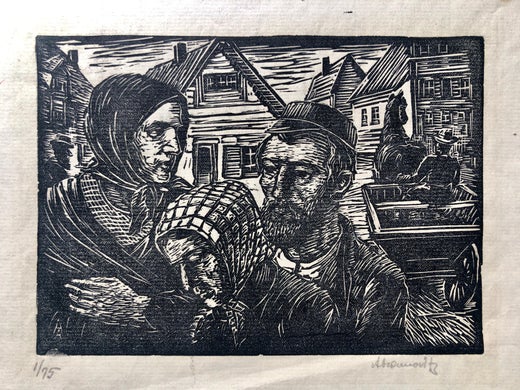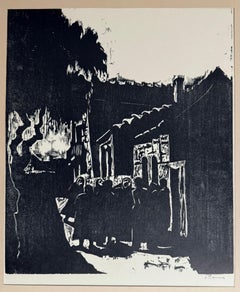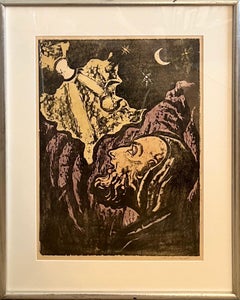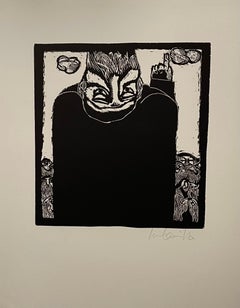Want more images or videos?
Request additional images or videos from the seller
1 of 9
Albert AbramovitzMacaques 4.35.Circa 1940s
Circa 1940s
$1,000List Price
About the Item
- Creator:Albert Abramovitz (1879-1963, American)
- Creation Year:Circa 1940s
- Dimensions:Height: 13.1 in (33.28 cm)Width: 10.5 in (26.67 cm)
- Medium:
- Movement & Style:
- Period:
- Condition:
- Gallery Location:Surfside, FL
- Reference Number:1stDibs: LU38210974632
Albert Abramovitz
Albert Abramovitz (1879-1963) was a painter and printmaker who was born in Riga, Latvia and studied art at the Imperial Art School in Odessa, Ukraine and in Paris, at the Académie de la Grande Chaumière. He was a member of the Paris Salon, serving on its panel for the review of juried works of art. He was also a member of the Societaire Salon d'Automne. He was awarded the Grand Prize at the 1911 Universal Exposition in Rome and Turin. In 1916, Abramovitz emigrated to the United States, first living in Manhattan then briefly in Los Angeles in the late 1920's, living in Brooklyn, New York the rest of his lfe. His work was exhibited across the United States in multiple shows and collections. Abramovitz produced murals for the Federal Arts Project Works Progress Administration in New York. His works are in the collections of the Smithsonian Museum of American Art, the British Museum, the Metropolitan Museum of Art, the New York Public Library, the Spencer Museum of Art, the University of Michigan Museum of Art, the Victoria and Albert Museum, and the Library of Congress.
About the Seller
4.9
Platinum Seller
Premium sellers with a 4.7+ rating and 24-hour response times
Established in 1995
1stDibs seller since 2014
1,833 sales on 1stDibs
Typical response time: 1 hour
Authenticity Guarantee
In the unlikely event there’s an issue with an item’s authenticity, contact us within 1 year for a full refund. DetailsMoney-Back Guarantee
If your item is not as described, is damaged in transit, or does not arrive, contact us within 7 days for a full refund. Details24-Hour Cancellation
You have a 24-hour grace period in which to reconsider your purchase, with no questions asked.Vetted Professional Sellers
Our world-class sellers must adhere to strict standards for service and quality, maintaining the integrity of our listings.Price-Match Guarantee
If you find that a seller listed the same item for a lower price elsewhere, we’ll match it.Trusted Global Delivery
Our best-in-class carrier network provides specialized shipping options worldwide, including custom delivery.You May Also Like
LARGE RARE OTTO MUELLER WOODCUT POSTER
By Otto Mueller
Located in Santa Monica, CA
OTTO MUELLER (German 1874 – 1930)
POTSDAMER KUNSTSOMMER, 1921 (1968) (Karsch 6)
Woodcut. Edition of 25 and numbered 11. There are no known
impressio...
Category
1920s Expressionist Figurative Prints
Materials
Woodcut
AGONY
Located in Santa Monica, CA
ROBERT PHILIPPI (Austrian 1877-1959)
KNEELING NUDE. c. 1923 (Chrastek, Widder 2019, p. 162, N° 461) (in Rifkind Collection, LACMA: From a portfolio of 1...
Category
1920s Expressionist Figurative Prints
Materials
Woodcut
POLSTER (The Cushion)
By Max Kurzweil
Located in Santa Monica, CA
MAXIMILLIAN KURZWEIL (Austrian 1867-1916)
DER POLSTER / THE CUSHION, 1903. Color woodcut printed on laid japon paper, affixed as usual to a support sheet from its upper sheet edge...
Category
Early 1900s Vienna Secession Figurative Prints
Materials
Woodcut
LOVERS (LIEBESPAAR
Located in Santa Monica, CA
ROBERT PHILIPPI (Austrian 1877-1959)
LIEBESPAAR (LOVERS) ca.1923 (in Rifkind Collection, LACMA: From a portfolio of 10 prints. Rifkind indicates the e...
Category
1920s Expressionist Figurative Prints
Materials
Woodcut
SITZENDER HARLEKIN
By Heinrich Campendonk
Located in Portland, ME
Campendonk, Heinrich. SITZENDER HARLEKIN. Engels/Sohn 59. Woodcut, 1922. 15 x 11 3/8 inches; 380 x 290 mm. Signed in pencil. In Excellent condition. Framed.
Category
20th Century Expressionist Figurative Prints
Materials
Woodcut
Christus, 1961 (Expressionist, Spiritual Theme)
Located in Kansas City, MO
Richard Haizmann
Christus, 1961
Woodcut
Year: 1987 (printed)
Size: 33.66 x 24.01 inches (85.5 × 61 cm)
Stamped verso by the Estate, signed "Dr. Wolfgang Wesiack"
COA provided
*Will ...
Category
1960s Expressionist Figurative Prints
Materials
Woodcut
'The Garden' — Celebrated Contemporary African American Artist
By Margo Humphrey
Located in Myrtle Beach, SC
Margo Humphrey, 'The Garden (Adam and Eve)', reductive color woodcut, 1989. Signed, dated, and annotated 'A/P' in pencil. Signed and dated in the image, lower right. A fine, richly-inked, artist's proof impression, with fresh, vivid colors, on BFK Rives, heavy, off-white wove paper; the full sheet with margins (1 to 1 3/8 inches), in excellent condition. Archivally sleeved, unmatted. Scarce.
Image size 27 1/4 x 39 1/8 inches (692 x 994 mm); sheet size 29 1/2 x 42 inches (749 x 1,067 mm).
ABOUT THIS WORK
"Humphrey continued to reinterpret stories from the Bible with African American figures. In 1989 she published the woodcut print 'The Garden' at Magnolia Editions in Oakland, CA. For this rare foray into relief printmaking, she employed the reductive method, which uses only one block that is successively carved for each color segment, reducing the block with each cutting. Technically challenging, this lush and elaborate print is a testament to Humphrey’s skills as a printmaker. A youthful Adam and Eve are depicted in a luxuriant tropical landscape. Here, Humphrey chooses not to include the traditional symbols of humanity’s downfall but instead portrays them as being protected by angels in an atmosphere of idyllic bounty. ...Although Humphrey challenges traditional representation of Christian themes, her images are not iconoclastic but present a broader, more inclusive engagement with religious spirituality."
— Adrienne L. Childs, 'Margo Humphrey, The David C. Driskell Series of African American Art: Volume VII,' Pomegranate Communications, Inc., 2009, page 71.
ABOUT THE ARTIST
American printmaker, illustrator, and art teacher Margo Humphrey was born in Oakland, California, in 1942. She earned a BFA in Painting and Printmaking from the California College of Arts and Crafts and a Master of Fine Arts degree in Printmaking from Stanford University.
Humphrey began teaching in 1973 at the University of California Santa Cruz and has since taught at the University of Texas at San Antonio, the San Francisco Art Institute, and the School of the Art Institute of Chicago. She has also taught at the University of the South Pacific in Suva, Fiji; Yaba Technological Institute of Fine Art, Ekoi Island, Nigeria; the University of Benin in Benin City, Nigeria; the Margaret Trowell School of Fine Art in Kampala, Uganda, and the Fine Art School of the National Gallery of Art, Harare, Zimbabwe. In 1989, she was appointed Department Head of Printmaking at the University of Maryland in College Park.
Humphrey has worked in lithography, monoprint, and woodcut with significant printmaking ateliers, including the Rutgers Center for Innovative Print and Paper, the Bob Blackburn Printmaking Workshop, and the Tamarind Institute in New Mexico. She was one of the earliest African-American woman artists to distinguish herself as a lithographer in a highly technical, male-dominated profession and was the first to have her prints published by Tamarind in 1974.
Humphrey’s imagery combines historical perspective, autobiography, and fantasy to illuminate her experience as an African American woman. Bold, saturated color, animated figures, and syncopated rhythmic arrangements are hallmarks of Humphrey's oeuvre. Though Humphrey labels her distinctive style "sophisticated naive," the narrative complexity and technical skill of her works attest to her artistic virtuosity. Joyful, expressive, and at times humorous, her works offer engaging commentary on the presumptions of American culture and myth while embracing her personal vision of authenticity and spirituality.
She developed her 1987 work The Last Bar-B-Que, a vividly colored transformation of the Last Supper, following a three-year period during which she examined portrayals of the iconic subject by artists from Pietro Lorenzetti to Emil Nolde. Her narrative work The Garden, a monumentally scaled reductive woodcut, is a further example of an archetypal subject—Adam and Eve in the Garden of Eden—debunked and rendered with fresh, life-affirming vibrancy.
Since her first solo exhibition in 1965, Humphrey’s works have been exhibited internationally. They are held in major institutions, including the Museum of Modern Art, The Smithsonian American Art Museum, the Philadelphia Museum of Art, the Hampton University Museum, the Victoria and Albert Museum (London), the Museum of Modern Art, Rio de Janeiro, and the National Gallery of Modern Art, Lagos. In 1996, she was invited to be part of the World Printmaking Survey at the Museum of Modern Art, New York.
In 2011, Hampton University Museum mounted a 45-year retrospective of Humphrey’s work Her Story: Margo Humphrey Lithographs and Works on Paper, jointly curated by Robert E. Steele, executive director of the David Driskell...
Category
1980s Expressionist Figurative Prints
Materials
Woodcut
$7,500
H 27.25 in W 39.13 in
'Karl Michel Exhibition' — German Expressionism
By Karl Michel
Located in Myrtle Beach, SC
Karl Michel, 'Austellung Karl Michel', woodcut, 1924, edition 20. Signed, dated, numbered 'op. 173' (the artist's inventory number) and '7/20' (the impression number/edition size) and annotated 'Vorgesdruck' (artist's proof) in pencil.
A fine, richly-inked impression on hand-made cream, wove paper, with full margins (1 1/16 to 1 1/2 inches); toning to the right sheet edge deckle, otherwise in good condition. With the artist's blind stamp in the bottom center margin. Designed and printed by the artist. Very scarce. Matted to museum standards (unframed).
An elegantly designed, dynamic exhibition announcement with the German copy in the block: 'Austellung Karl Michel – Deutsches Buchmuseum Leipzig/Zeitzer str 12, Berlin S.W. 61 Teltower str 33 / Buchschmuck/ Plakate/ Anzeige/ Schultzmarke/ Illustrations/ Ex Libris'. English translation: 'Karl Michel Exhibition – German Book Museum, Leipzig Zeitzer Street 12, Berlin, S.W. 61 Teltower St. 33. / Book Decoration / Posters / Announcements / Illustrations / Ex Libris.'
Image size 6 x 4 inches (152 x 102 mm); sheet size 8 1/16 x 5 1/2 inches (205 x 140 mm).
ABOUT THE ARTIST
Karl Michel (1889-1984) was a noted graphic designer and expressionist printmaker during Germany's pre-Nazi Weimar Republic (1919-1933). Michel’s work was the subject of a feature article in the influential German graphic design magazine 'Das Plakat' (The Poster) in 1920. An anti-war advocate, Michel created a suite of 12 wood engravings depicting his impressions of the humanitarian toll of WWII entitled ‘Humanitas’ (Humanity). The German publishing house Greifenverlag published the series in a folio of unsigned prints.
Michel’s graphic work is held in the permanent collections of the Auckland War Memorial Museum (New Zealand), Frederikshavn Kunstmuseum & Exlibrissamling (Denmark), Museum of Applied Arts (Budapest), The Robert Gore Rifkind Center for German Expressionist Studies at the Los Angeles County Museum of Art, and the German Expressionism...
Category
1920s Expressionist Figurative Prints
Materials
Woodcut
'Viel Gluck 1923' (Good Luck Wishes) — German Expressionism
By Karl Michel
Located in Myrtle Beach, SC
Karl Michel, 'Viel Gluck 1923 Wunscht der Graphikverlag, J.G. Holzwarth/Bad Rothenfelde', woodcut, 1922, edition 20. Signed and numbered op. 135d and 20/20 in pencil. Signed in the image, lower left. Annotated 'Vorgesdruck' [artist’s proof] in pencil. A fine, richly-inked impression, on heavy, cream Japan paper, with full margins (5/8 to 1 1/8 inches), in good condition. With the artist’s blind stamp in the top left margin. Printed by the artist. Matted to museum standards, unframed.
New Year's Greeting - "1923, Good Luck Wishes from the Graphic Press, J.G. Holzwarth/Bad Rothfelde."
Image size 5 x 3 1/2 inches (127 x 89 mm); sheet size 6 5/8 x 5 7/8 inches (168 x 149 mm).
ABOUT THE ARTIST
Karl Michel (1889-1984) was a noted graphic designer and expressionist printmaker during Germany's pre-Nazi Weimar Republic (1919-1933). Michel’s work was the subject of a feature article in the influential German graphic design magazine Das Plakat (The Poster) in 1920. An anti-war advocate, Michel created a suite of 12 wood engravings depicting his impressions of the humanitarian toll of WWII entitled ‘Humanitas’ (Humanity). The German publishing house Greifenverlag published the series in a reduced folio of unsigned prints.
Michel’s graphic work is held in the permanent collections of the Auckland War Memorial Museum (New Zealand), Frederikshavn Kunstmuseum & Exlibrissamling (Denmark), Museum of Applied Arts (Budapest), The Robert Gore Rifkind Center for German Expressionist Studies at the Los Angeles County Museum of Art, and the German Expressionism...
Category
1920s Expressionist Figurative Prints
Materials
Woodcut
$300
H 5 in W 3.5 in D 0.01 in
Der Hirte (The Shepherd) — original hand-coloring
Located in Myrtle Beach, SC
Richard Seewald, 'Der Hirte (The Shepherd)', woodcut with hand coloring, c. 1919. Unsigned as published in 'Genius', Vol 1, no. 1, 1919. A fine, richly...
Category
1910s Expressionist Figurative Prints
Materials
Woodcut
More From This Seller
View AllMacaques 4.35.
By Albert Abramovitz
Located in Surfside, FL
Abramovitz, Albert 1879-1963
Born in Riga, Latvia, Abramovitz studied art at the Imperial Art School in Odessa and at the Grande Chaumière in Paris. In Paris, he became a member of ...
Category
20th Century Expressionist Figurative Prints
Materials
Woodcut
German Expressionist Woodcut Print Pencil Signed israeli Jerusalem Jacob Pins
By Jacob Pins
Located in Surfside, FL
Jacob Otto Pins (17 January 1917 – 4 December 2005) was a German-born Israeli woodcut artist and art collector, particularly of Japanese prints and paintings.
Jacob Pins was born in ...
Category
20th Century Expressionist Figurative Prints
Materials
Woodcut
Jewish Rabbi Looking Heavenward German Expressionist Woodcut Israeli "Psalm"
By Jacob Steinhardt
Located in Surfside, FL
Jacob Steinhardt, 1887-1968
Hand signed in pencil, woodblock print woodcut.
Frame: 22.5" x 18"
Image: 16.75" X 12.5"
"Psalm"
12/30
Jakob Steinhardt, Painter and Woodcut Artist. b. 1887, Yaacov Steinhardt was born in the then remote, largely Polish town of Zerkow in the Posen District of Germany. (poland/german) Immigrated 1933. Studies: 1906 School of Art, 1906 Studied in Berlin Arts and Crafts School. Berlin; 1907 painting with Lovis Corinth and engraving and etching with Hermann Struck; advanced studies, 1908-10 Paris, with Henri Matisse and Steinlen; 1911 Italy. Teaching: Bezalel, Jerusalem, 1953-57 Director. 1910 Participated in the “New Sezession”, Berlin. 1912 together with Ludwig Meidner and Janthur he founded the "Pathetiker" group very early in the German expressionist movement. Running afoul of the Nazis, he fled to Tel-Aviv and then Jerusalem in the early 30s, showing in “Der Sturm” Gallery. 1914 Exhibited with ludwig Meidner at first Expressionist Exhibition in Berlin. Worked mainly in woodcuts depicting biblical and other Jewish subjects. 1955-58 International awards for his woodcuts. receives graphic commissions from Fritz Gurlitt. 1922 Marries Minni Gumpert. Active in organizing Secession exhibits. 1925 Trips to Mark Brandenburg and Holy Land. Turns primarily to painting; stops work on etchings and lithographs. 1933 Emigrates to the Palestine. 1934 Moves to Jerusalem and opens an art school; attempts some etchings. 1948 Closes the art school and becomes Chairman of Graphics Department, Bezalel School for Arts and Crafts. 1954-57 Director of Bezalel School for Arts and Crafts. Taken up by J. B. Neumann who became the agent for his etchings. Exhibited Sturm Gallery, Herbst-salon. 1914 Outbreak of World War I; Steinhardt enlists in German army. 1916-18 First on Eastern Front in Poland and Lithuania, then after short training period in Berlin, sent to Macedonia. 1917 Exhibition of Lithuanian drawings at Berlin Secession in Spring. Elected member of the Secession.
He often used wood-cutting techniques that were popular amongst German Expressionists. Steinhardt was driven to express ideas clearly and decisively through art.
Amongst the themes found in his work the prophets of the Bible, such as Jonah, are noticeable. Steinhardt identified deeply with Jonah due to his attempt to run from God's call to duty.
Additionally, the image of beggars was often found in Steinhardt's works and in his artistic presentation of the less fortunate, the artist's love for his fellow man becomes evident.
Moreover, the grotesque was a theme noticeable in Steinhardt's earliest pieces. These were fantastical images; it was unclear whether or not they were human or demon. In the 1950's, Steinhardt returned to these images upon learning of the Holocaust of Europe's Jews. At that time he resided in New York and there, in the shadow of the skyscrapers, Steinhardt's reaction to WWII was expressed through his art.
A Collection of Works by Artists of the Land of IsraelThe Bezalel National Museum, Jerusalem 1940 Artists: Shemi, Menahem Rubin...
Category
20th Century Expressionist Figurative Prints
Materials
Woodcut
Latin American Judaica Conceptual Chassidic Art Modern Woodcut Luis Camnitzer
By Luis Camnitzer
Located in Surfside, FL
Luis Camnitzer and Martin Buber (1878-1965),
New York: JMB Publishers Ltd, 1970.
Printed at The New York Graphic Workshop.
Hand signed on Arches paper. (Edition 24/100, numbered on Justification page)
Woodblock prints based on folktales from the Hasidic Jewish tradition in Eastern Europe, selected by Camnitzer from the early masters section of Buber’s Die chassidischen Bücher as translated by Olga Marx. German Expressionist style Jewish woodcuts...
Category
1970s Expressionist Figurative Prints
Materials
Woodcut
Post Soviet Avant Garde Russian Woodcut Print With Hand Watercolor Painting
By Ilya Shenker
Located in Surfside, FL
This depicts a wedding scene in a style of German Expressionism. hand signed and hand painted in watercolor.
Ilya Shenker, Russian/American (1922 - )
As a soldier in World War II, he survived where millions perished. Upon returning to his home town of Odessa, felt abandoned and alone. He studied Art and Architecture in Odessa, but, one of a number of Russian Jewish artists allowed to emigrate, he left for America when the opportunity arose. He settled in New York City, a choice that has forever impacted his oeuvre. Many of his pictures depict New York cityscapes and lifestyle; however, they remain typically Russian. His subject matter often comes from memory and includes the life that he left behind, family, and friends. Drawing upon his Jewish heritage for inspiration, Shenker also paints historical events, such as "On the Eve of the Assault" in which he portrayed the last night before the destruction of Jerusalem. He has also illustrated a number of classics of Russian literature including Alexander Pushkin. His use of imagination also applies to the figures in his expressionist paintings—fictional characters such as the Spanish literary character Don Quixote make appearances in his work. He has also placed figures such as Rembrandt and Picasso in modern settings: in "Rembrandt Visiting our Family," Shenker sits his most favored artist at his family table, in a tribute to someone he describes as a "peoples artist." He is one in a long line of great Soviet Russian Judaica Jewish artists beginning with Yehuda Pen, who founded Russia's first art school for Jews in Vitebsk in 1897 continuing with his students, including Marc Chagall and El Lissitzky, Natan Altman, Leon Bakst and Robert Falk...
Category
1960s Expressionist Figurative Prints
Materials
Watercolor, Woodcut
German Israeli Expressionist Woodcut Print Pencil Signed Street Fight
By Jacob Pins
Located in Surfside, FL
Jacob Otto Pins (17 January 1917 – 4 December 2005) was a German-born Israeli woodcut artist and art collector, particularly of Japanese prints and paintings.
Jacob Pins was born in Höxter, Germany, the son of Dr Leo Pins, a veterinarian, and his wife Ida Lipper. He immigrated to Palestine in 1936 to study art. His father tried to discourage him from becoming an artist for financial reasons.
Pins' younger brother, Rudolph, (1920-2016) moved to the United States in 1934. His father was sent to Buchenwald. In July 1944, both parents died in the Riga ghetto.
Pins first lived on a kibbutz, which was disbanded in 1941. He moved to Jerusalem and studied woodcut and linocut under woodcut master and painter Jacob Steinhardt, also a German immigrant, at his small private school. He lived in poverty in a tiny room, subsisting on a meagre diet. He continued his studies at the new Bezalel Academy of Art and Design.
Pins was married to Elsa, the subject of a number of his prints. They had no children.
Pins bought his first Oriental print in 1945, and acquired a house on Ethiopia Street, opposite the Ethiopian church, where he lived for the rest of his life. He continued collecting until his death and was one of Israel's foremost art collectors. His book on Japanese Pillar Prints, Hashira-e is the definitive work on the subject.
Pins died in Jerusalem in December 2005.
Pins' artwork was heavily influenced by German expressionism and traditional Japanese wood block printing. From 1956 to 1977, he taught at Israel's leading art schools, most notably Bezalel, where he later became a professor. He was known as a demanding teacher, emphasizing strong technical skills and discipline.
In the 1950s, Pins helped to found the Jerusalem Artists' House, a centre for the city's artists to meet and exhibit.
Legacy
Pins' extensive collection of Japanese woodprints...
Category
20th Century Expressionist Figurative Prints
Materials
Woodcut
Recently Viewed
View AllMore Ways To Browse
Klimt Eisler
Le Coq Vintage
Lithograph On Board
Marilyn Monroe Lithograph
Matisse Odalisque
Moulin Rouge Lautrec
New York City Vintage Poster
Nicola De Maria
Pablo Picasso Limited Edition
Picasso 1965
Picasso Bullfight
Picasso Linoleum Cut
Picasso Marie Therese
Picasso Paix
Picasso Pique
Portrait Of Marguerite
Renoir Originals
Richard Wentworth



